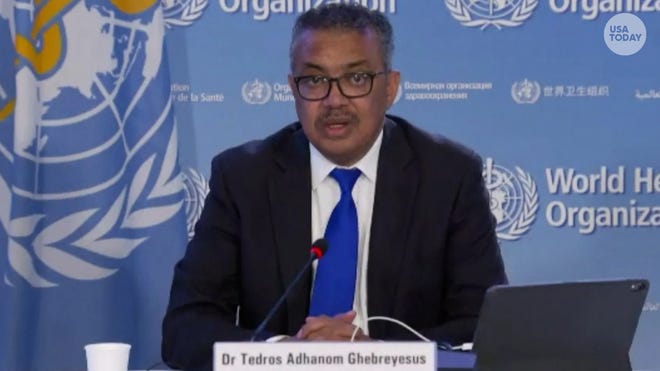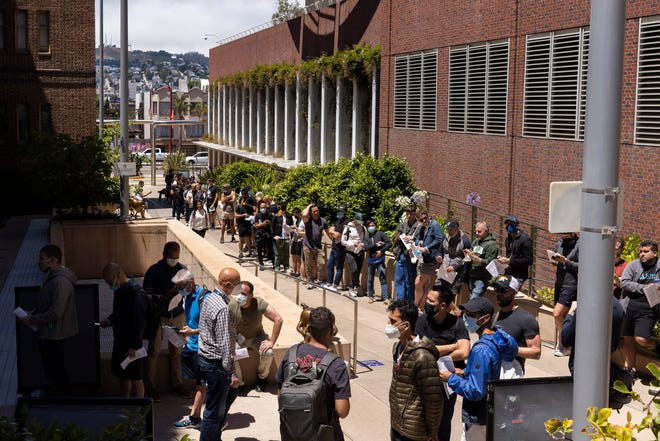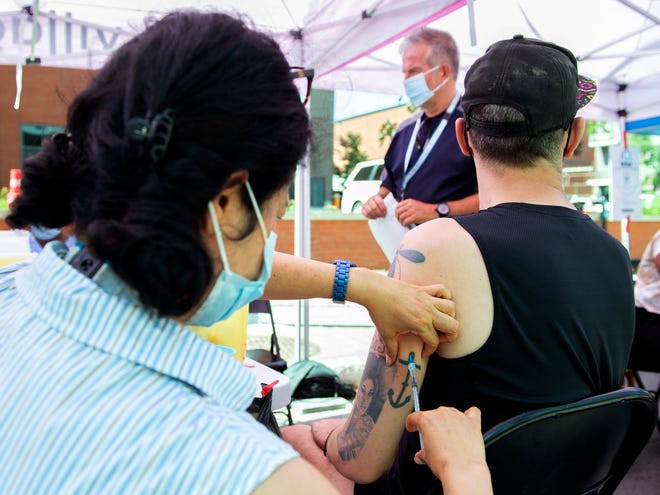Health
Symptoms, vaccine, treatment options and more

The monkeypox outbreak, first spotted in Europe in late April, has now reached 75 counties, the vast majority of which have never had significant caseloads before.
The U.S. now has had the most people infected, with more than 3,500 of the world’s 17,000 diagnoses. Spain, with the next-highest case load of more than 3,100, has one-seventh of our population. New York City, with more than 1,000 cases, sits at the epicenter of the U.S. outbreak.
On Friday, the World Health Organization declared monkeypox a “public health emergency of international concern,” joining COVID-19 and polio in that designation.
Dr. Ashish Jha, the White House coronavirus response coordinator, described the decision in a Tuesday briefing as “a call to action to the world community to stop the spread of this virus.”
Here are some prevention strategies and government actions being taken amid the outbreak, along common misconceptions about monkeypox infections.
Yes, a rash is one monkeypox symptom.
Monkeypox generally starts with flu-like symptoms – fever, swollen glands, muscle aches and headaches. A rash usually develops a few days later, though in this outbreak it sometimes comes first, said Dr. Marshall Glesby, an infectious disease specialist at Weill Cornell Medicine and New York-Presbyterian.
In the classic presentation seen in Africa, the lesions start on the hands and face, he said, but with this outbreak some of the lesions may be in the mouth or anus and therefore hard to see, and they may concentrate around the genital area, mouth or backside.
The lesions can cause severe pain, both persistently, and depending on the location, when using the bathroom or eating.
Sometimes the rash can lead to permanent scarring, and bacterial infections can occur on top of skin lesions, Glesby said.
The overwhelming majority of monkeypox patients at Weill Cornell have been treated as outpatients, he said, with only a few hospitalized for pain control.
Five people have died around the world since late April, though the risk appears to be lower in wealthier countries. “People with better nutritional status and who are healthier, they just do better,” said Dr. Ali Khan, an epidemiologist and dean of the College of Public Health at the University of Nebraska Medical Center.
No, monkeypox is not a sexually transmitted infection.
Any close, skin-to-skin contact can transmit monkeypox.
Yes, the outbreak has mainly affected men who have sex with men, and it’s possibly transmissible via semen, Glesby said. But the virus doesn’t care who is infected.
Two children in the U.S. in close contact with infected family members have been diagnosed with the virus.
Many adults diagnosed with monkeypox in this outbreak also have simultaneous sexually transmitted infections. Other infections should be considered when testing someone for monkeypox. If an STI is being considered as a diagnosis, a health care provider should also think about monkeypox, Glesby said.
No, you can’t catch monkeypox from a handshake or a toilet seat.
Monkeypox doesn’t pass through casual contact, like shaking hands, a quick peck on the cheek or sharing a toilet seat.
It can theoretically be transmitted by touching clothing or sheets used by people with open sores and through the air if someone has mouth sores, but there is no evidence anyone has caught it that way during this outbreak, Khan said.
“This seems to really require close, prolonged skin-to-skin contact,” he said. If it didn’t, “we’d have millions of cases by now.”
No, the gay community shouldn’t be blamed for monkeypox.
Gay people should not be stigmatized just because the virus started circulating among men who have sex with men, said Dr. Mahdee Sobhanie, an infectious disease specialist at the Ohio State University Medical Center.
“Don’t think of this as a gay disease. It’s a disease that can occur through close contact,” he said.
Monkeypox has probably been quietly spreading and evolving in and around Nigeria for the past four to five years, Khan said. It came to public attention only this spring when there was an apparent superspreader event among raves and bathhouses in Europe that “explosively sent this worldwide,” he said.
The communities most affected by monkeypox have done a good job of communicating the risk and educating people, Khan said. “They’re being very responsible and showing up to get vaccinated.”
Still, the U.S. should have been better prepared.
“I find it unexplainable why vaccine was not already stockpiled in the U.S. for this eventuality, as it should be,” he said. “On top of which, (the Department of Health and Human Services) could have done a better job the moment they knew there were cases.”

No. The general public is not at high risk. Yes there are things to do to protect yourself.
At the moment, the people at highest risk for infection are men who have sex with male partners. “Being careful about who you’re having sex with,” Khan said. Making sure they’re not infected can help reduce risk.
Men who have sex with men and others at high risk, including health care workers who treat patients with monkeypox and family members of those infected, should get vaccinated if possible, he said.
“And if you think you may be infected, immediately go get a diagnosis and get isolated and treated so you can’t infect anyone else,” he said.
For people at lower risk, there’s nothing needed at this point for protection, except to support local, state and federal public health systems, he and Glesy said.
“The one lesson that hopefully will be learned is that there really needs to be better support of the public health infrastructure of this country,” Glesby said. “Fundamentally, the United States has an under-resourced public health system.”
Yes, you can call it a pandemic.
“Given how widespread it is throughout the world, I would call it a pandemic,” Glesby said.
Yes, tests are available now.
Testing was initially hard to access, but commercial labs have recently increased the nation’s capacity to more than 70,000 tests a week.
Tests are conducted on pus from lesions, but officials with the Centers for Disease Control and Prevention said they are exploring the possibility of tests based on saliva, throat swabs and blood.

Yes, there is an effective vaccine.
Vaccines seem to work well against monkeypox, though they were developed to prevent smallpox, its much deadlier cousin.
Two vaccines can be used against monkeypox, but only one is being widely prescribed during this outbreak, and it is in short supply.
The U.S. government funded the development of the vaccine Jynneos and preordered some supply, though only 2,000 doses were available in early May when it became clear the virus was spreading.
By the end of May, 72,000 doses were available, and this month, the government distributed another 300,000 doses with millions more on order, said Dawn O’Connell, assistant secretary for preparedness and response with the Department of Health and Human Services, in a news conference this month.
The administration announced Wednesday that another 786,000 doses are now available.
Shots are provided free, though there have been long lines in some cities and access has not been equitable across all regions and populations.
The other vaccine, ACAM2000, should not be used to treat people who are immune-compromised, such as those who are HIV-positive, and can cause more significant side effects. Millions of doses are available in the U.S. stockpile, but only one state has requested it so far.

Khan said it would make sense to use ACAM2000 widely only “if this became a significant outbreak with more people getting hospitalized and dying.”
A full course of Jynneos requires two shots, with the second at least one month after the first. But New York, Washington, D.C., and other major cities have been deferring second shots because of the limited supply.
Although the CDC has recommended two doses for full, long-term protection, Glesby said it makes sense to defer second doses in the interest of protecting more people.
“We don’t know with this particular vaccine” how much protection is provided by the first dose, he said.
Patients can get treatment.
An antiviral called tecovirimat, sold under the brand name TPOXX, has been approved to treat smallpox and is now being used to treat people with monkeypox.
TPOXX can prevent infection if given before or within four days of exposure, Khan said, and prevents severe disease if given up to two weeks after someone is exposed to the virus.
It was tested in healthy people to check for side effects, but it has not been used before against people infected with monkeypox, Glesby said. There are plans for research on those getting the drug, but those studies are not up and running yet, he said.
Because most people recover without treatment, a clinical trial with a placebo arm will be needed to prove whether TPOXX can safely reduce symptoms, lead to faster recovery or prevent complications, he said.
Still, Glesby said, the 30 or so patients treated with TPOXX in his program have fared well.
No, you don’t catch monkeypox from monkeys.
The disease was first identified in a monkey, hence the name, but humans don’t catch it from monkeys, and the World Health Organization is trying to change the name to avoid confusion.
Ropoe squirrels in parts of central and western Africa have been identified as a carrier of monkeypox. They pass the infection to people who hunt or eat them, and then perhaps from those people to others, Khan said.

Yes, the virus is evolving.
Monkeypox’s genes come in the form of DNA, which don’t mutate as much as RNA-based viruses, like the SARS-CoV-2 virus, which causes COVID-19.
Still, Khan said, over the past four years, the virus has acquired a lot more changes than expected, probably because it silently passed from person to person in places like Nigeria, with only the most transmissible variants surviving.
The virus seems different during this global outbreak than in previous, more localized outbreaks, Glesby said, but “whether that’s due to genetic differences in the virus remains to be seen.”
Luckily, the version of monkeypox that has been circulating seems to be less deadly than a strain known to have caused illness in central Africa.
Is this outbreak out of control? No one knows.
Monkeypox data has been hard to come by. “I don’t think we have a real good handle on the true scope of disease and how fast it’s spreading,” Khan said.
States generally collect information but often lack an easy way of sharing it with the federal government.
Right now, no one is tracking who is getting vaccinated or infected before or after vaccination, he and Glesby said.
“It’s hard to really judge and tell where the disease currently is,” Khan said.

Yes, the government made some of the same mistakes this time as in the early days of COVID-19. It’s trying to fix them.
As with COVID-19, government bureaucracy slowed testing, vaccinations and treatments during the first weeks of the outbreak.
Most of the problems appear to have been addressed now. Though monkeypox tests were concentrated at the CDC at first, commercial labs now offer tens of thousands of tests a day.
Vaccine doses owned by the U.S. government sat in Europe for weeks awaiting a signoff from the FDA, but they’re now available and more have been ordered.
Paperwork was paralyzing the release of the antiviral TPOXX, but the CDC has since simplified the process and made it easier and faster to receive treatment.
The situation is better, but the early, repeated mistakes should serve as a warning, Khan said.
“We need to cut this time frame down in future pandemics,” he said, and added that there are many more actions the government could take to be better prepared. “I’m worried about the next coronavirus, I’m worried about the next flu that could kill hundreds of thousands and millions of people.”
Contact Karen Weintraub at [email protected].
Health and patient safety coverage at USA TODAY is made possible in part by a grant from the Masimo Foundation for Ethics, Innovation and Competition in Healthcare. The Masimo Foundation does not provide editorial input.
|
Sources 2/ https://www.usatoday.com/story/news/health/2022/07/27/monkeypox-explained-symptoms-vaccine-treatment-options/10152078002/ The mention sources can contact us to remove/changing this article |
What Are The Main Benefits Of Comparing Car Insurance Quotes Online
LOS ANGELES, CA / ACCESSWIRE / June 24, 2020, / Compare-autoinsurance.Org has launched a new blog post that presents the main benefits of comparing multiple car insurance quotes. For more info and free online quotes, please visit https://compare-autoinsurance.Org/the-advantages-of-comparing-prices-with-car-insurance-quotes-online/ The modern society has numerous technological advantages. One important advantage is the speed at which information is sent and received. With the help of the internet, the shopping habits of many persons have drastically changed. The car insurance industry hasn't remained untouched by these changes. On the internet, drivers can compare insurance prices and find out which sellers have the best offers. View photos The advantages of comparing online car insurance quotes are the following: Online quotes can be obtained from anywhere and at any time. Unlike physical insurance agencies, websites don't have a specific schedule and they are available at any time. Drivers that have busy working schedules, can compare quotes from anywhere and at any time, even at midnight. Multiple choices. Almost all insurance providers, no matter if they are well-known brands or just local insurers, have an online presence. Online quotes will allow policyholders the chance to discover multiple insurance companies and check their prices. Drivers are no longer required to get quotes from just a few known insurance companies. Also, local and regional insurers can provide lower insurance rates for the same services. Accurate insurance estimates. Online quotes can only be accurate if the customers provide accurate and real info about their car models and driving history. Lying about past driving incidents can make the price estimates to be lower, but when dealing with an insurance company lying to them is useless. Usually, insurance companies will do research about a potential customer before granting him coverage. Online quotes can be sorted easily. Although drivers are recommended to not choose a policy just based on its price, drivers can easily sort quotes by insurance price. Using brokerage websites will allow drivers to get quotes from multiple insurers, thus making the comparison faster and easier. For additional info, money-saving tips, and free car insurance quotes, visit https://compare-autoinsurance.Org/ Compare-autoinsurance.Org is an online provider of life, home, health, and auto insurance quotes. This website is unique because it does not simply stick to one kind of insurance provider, but brings the clients the best deals from many different online insurance carriers. In this way, clients have access to offers from multiple carriers all in one place: this website. On this site, customers have access to quotes for insurance plans from various agencies, such as local or nationwide agencies, brand names insurance companies, etc. "Online quotes can easily help drivers obtain better car insurance deals. All they have to do is to complete an online form with accurate and real info, then compare prices", said Russell Rabichev, Marketing Director of Internet Marketing Company. CONTACT: Company Name: Internet Marketing CompanyPerson for contact Name: Gurgu CPhone Number: (818) 359-3898Email: [email protected]: https://compare-autoinsurance.Org/ SOURCE: Compare-autoinsurance.Org View source version on accesswire.Com:https://www.Accesswire.Com/595055/What-Are-The-Main-Benefits-Of-Comparing-Car-Insurance-Quotes-Online View photos
to request, modification Contact us at Here or [email protected]



